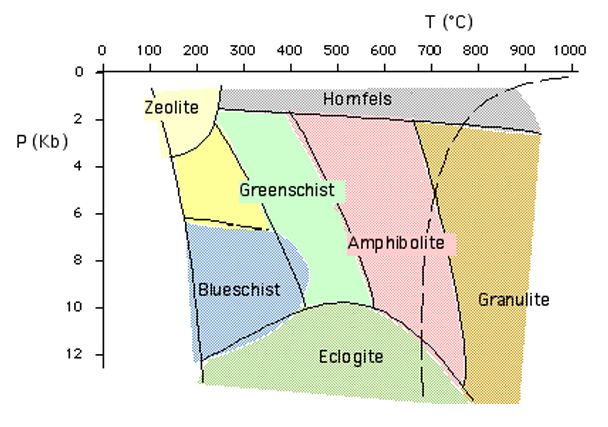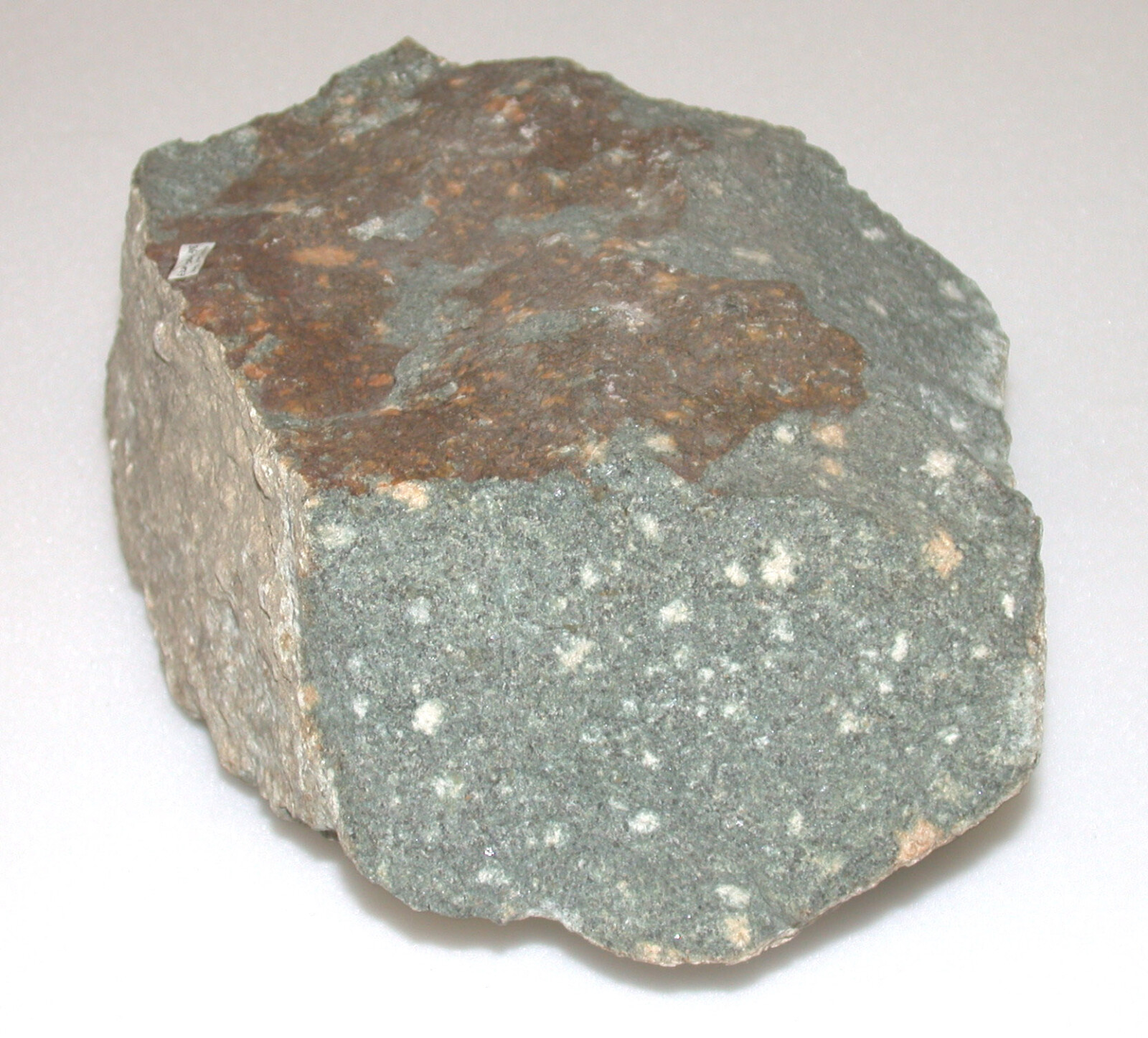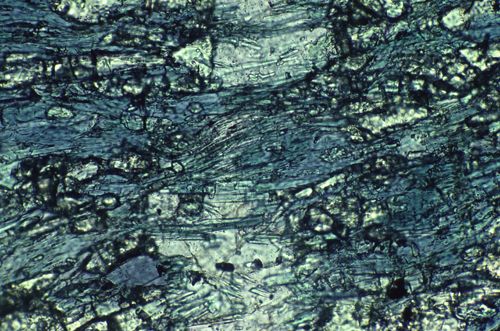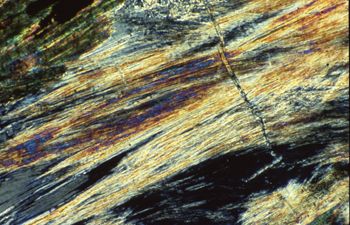Metamorphic Minerals
Metamorphic rocks yield many attractive minerals, such as garnet, corundum (varieties of which include sapphire and ruby), and kyanite. The word ‘metamorphic’ comes from Greek and means ‘to change form’ and these rocks were originally igneous and sedimentary rocks that have been altered by heat and/or pressure. This results in the formation of new minerals and changes in the texture and structure of the original rock. Unlike igneous processes, whereby the rock becomes molten as magma, all metamorphic changes occur in solid rock. The most commonly known metamorphic rocks are marble (transformed limestone) and slate (transformed mudstone).

Diagram to indicate the temperature and depth (reflected as pressure) at which various metamorphic facies develop. Under each of these facies a particular rock type (e.g. basalt) will form a predictable suite of minerals. Image: Peter Whitehead.
Metamorphism occurs over a wide range of temperatures and pressures. The least metamorphosed rocks form a continuum with diagenesis (see Sedimentary Minerals) and at the highest grade metamorphism is terminated when the rock melts to form magma (see Igneous Minerals). Variations in pressure and temperatures are mapped into a series of zones known as metamorphic facies (see diagram above). Within each of these facies a rock of a particular composition (e.g. basic igneous rock or limestone) will crystallize a predictable suite of metamorphic minerals. Metamorphic rocks therefore provide a record of the pressures and temperatures that have affected the rocks in a given district, from which information such as their depth of burial and their tectonic history can be deduced.
Metamorphic rocks may be referred to more generally as very low grade (zeolite facies), low grade (prehnite-pumpellyite and greenschist facies) medium grade (amphibolite facies), and high grade (upper amphibolite and granulite facies). They may also be classified as being formed by regional metamorphism (such as that which affected much of Wales) or contact metamorphism; a local heating and recrystallization of rocks invaded and heated by magma.
Metamorphic Rocks in Wales (1)

Preseli bluestone showing typical spotted texture formed by the growth of secondary albite plagioclase during low-grade greenschist metamorphism of the original igneous dolerite. National Museum of Wales Collection. © National Museum of Wales.
Most rocks in Wales are of low metamorphic grade (greenschist facies or lower), with the youngest rocks often showing the least effects of metamorphism. Higher grades of metamorphism are rare, and are known only from small areas of Precambrian rocks, or locally where igneous rocks have heated and baked the rocks they have invaded .
The Ordovician basic igneous rocks, such as those described under the Igneous Rocks section, have all been metamorphosed to some extent and the original igneous minerals overprinted by metamorphic ones. For instance the primary pyroxenes or olivine are replaced by minerals such as actinolite, chlorite, prehnite and pumpellyite. The plagioclase in these rocks is typically transformed to a more sodium (albite-rich) composition. The most famous example of a metamorphosed basic rock from Wales is the Preseli Bluestones from Pembrokeshire, which were used in the construction of Stonehenge.
Wales is dominated by sedimentary rocks, of which mudstones, are a prominent component. When transformed by metamorphism, mudstone does not contain such a varied metamorphic mineralogy as basic igneous rocks. However they are rich in clay and muscovite family minerals and these change in a systematic way as temperature increases in a rock during burial. By extracting the small flakes of white mica from a rock and analysing them by X-ray diffraction, the exact variety of mica can be determined and an estimation of metamorphic grade assigned. Wales is famous for its metamorphosed mudstones, which, if metamorphosed under the optimum conditions, yield the best quality slate in the world. Most variations in the colour of slate are produced by the presence of small quantities of other minerals. For instance black slate is rich in graphite, green varieties rich in chlorite or iron and red and purple slate contain oxidized iron.

Thin section image of purple slate from Bethesda, North Wales. The red line represents the orientation of the slaty fabric formed by the growth of mica. The larger, bright grains are detrital mica and quartz from the original sediment. Width of image 4.5 mm.

Thin section image of blueschist from near Llanfairpwllgwyngyll, Anglesey. The blue amphibole is of glaucophane or ferroglaucophane composition. Width of image 0.75 mm.
Some of the most unusual metamorphic rocks in Wales are blueschists exposed in southern Anglesey. These rocks are rich in the blue amphibole (glaucophane/ferroglaucophane) and formed under similar low temperatures to greenschists (300-400°C) but at far greater depths (up to 30 km). They are interpreted as having formed in a subduction zone in very latest Precambrian times, around 550-560 million years ago.

Thin section, photographed under the microscope, of sillimanite needles in high-grade metamorphic rocks from northeast Anglesey (Coedana Complex gneisses). © National Museum of Wales.
Higher grade metamorphic rocks are found in Anglesey and at the westerly tip of Pen Llŷn. The basic rocks, referred to as amphibolites, have been transformed to hornblende and plagioclase and may also contain garnet. In Anglesey these rocks are associated with metamorphosed sediments which now form impure marbles, but were originally muddy limestone horizons, and rocks containing sillimanite, biotite and garnet. Locally these rocks show evidence of melting, reflecting heating and burial under amphibolite facies conditions.
